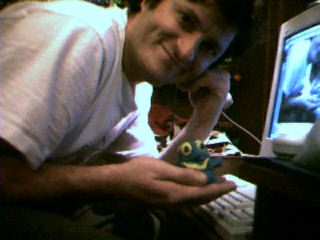I planned what pointer concepts should be in the video. I used concepts so basic that they are true in all languages.
I wrote a basic plot between the offscreen voice and Binky. I figured out who talks when, and roughly how long in seconds their speeches are -- 10 hours of planning to get this far.
I played around with different materials for the video -- string, Plah-Doh etc. I made some little screen tests, play around with lighting and logistics.
I used two desktop halogen lamps to illuminate the "set" which is a little table next to my computer. The camera is taped to a pile of books about 1 foot up and 2 feet over from the set floor. A gray T-shirt pinned to the wall behind the stage is the background.
I shot a half-length preliminary version which I ended up throwing out, but where I got better at the planning and logistics for getting the video right.
I shot all the final video in one night. For this step, I give great credit to the QuickCam camera and QuickTime software. The QuickCam is a little camera which sends what it sees to a host computer in digital form. It's included software supports a "stop action" mode where each time you click a button, it snaps the current scene and adds it to the end of a growing movie. The video is about 200 seconds long, so at 5 frames per second that's about 1000 individual frames. I had everything pretty well set up and planned before hand. My chair hovered right over the set and I had most of the Plah-Doh and props pre-built. I could reach in, adjust things slightly, lean out, and click off a frame. Repeat.
Right before the final shooting, I realized that the easiest way to cover time during the speeches was to move Binky's eyes and eyebrows around rather than moving Binky -- I could move just the head features and click off a frame pretty quickly .
I made errors a few times during production. An eyebrow would fall off, but I would not notice right away and so produce video with a wrong looking Binky. I had to delete the bad frames, back the whole set arrangement up to the last good point, and shoot forward from there. The QuickCam software (which is itself based on QuickTime) is very basic, but with practice it can navigate these situations nicely. There were maybe four problems like that. In any case, the shooting went until 3:00 a.m. having started at 10:00 p.m.
At this point I had lots of video and no sound. Up to this point, things had proceeded pretty quickly -- maybe 40 total hours of preparation and shooting to get the video.
Next I worked on the script more.
Then I worked on the logistics of dubbing the speech over the right parts of the video. This required reading the text many times. Partly to get the voicing right. Partly to tune the text itself. This part took a surprisingly large amount of time with many adjustments and repetitions of little parts of the voicing. In places I would adjust the duration of parts of the (silent) video to better match the timing needed by voicing. Overall the sound took another 30 hours or so.
At some point, I decided to add the last "summary" section -- it just uses video from the earlier section, with new text and voice overs.
All of the video and sound editing was done with the free version 2.5 of Apple's QuickTime software. It's simple, but very capable. With version 3.0, the free version only plays, and Apple charges $30 or so for the "Pro" editing capabilities I used. QuickTime did a great job for me, although I think the part of the 3.0 version which pesters you to upgrade to QuickTime Pro "now" or "later" is unnecessarily irritating for an otherwise fine product.
All of the above work was done on an ordinary Apple PowerMac 4400 -- A 200 Mhz PowerPC 603e -- a pretty lame machine compared to the current G3's, but perfectly adequate for the job.
For the last part of the content, I needed to edit together the text for the bottom of the screen, and work on overlaying all the different versions -- 15 hours.
I experimented with the many different formats that QuickTime can export, before finally setting on using the Video codec for the video and the IMA sound codec. These worked on both Macs and PCs.
Finally, I created the companion text.

The stage for the video -- the camera is the little ball connected to the computer on right. The camera is taped to a pile of books so it can look down on the set. It's important that the camera not move during the shooting of the video.

Nick with Binky -- the stage is behind us.

The sound recording area -- a microphone on a pillow. The computer is under the desk buried in blankets to muffle its fan and disk noise so as not mess up the voice recordings. The lessening in noise made the room so much more pleasant, I have kept them there after the recording.